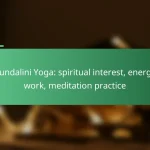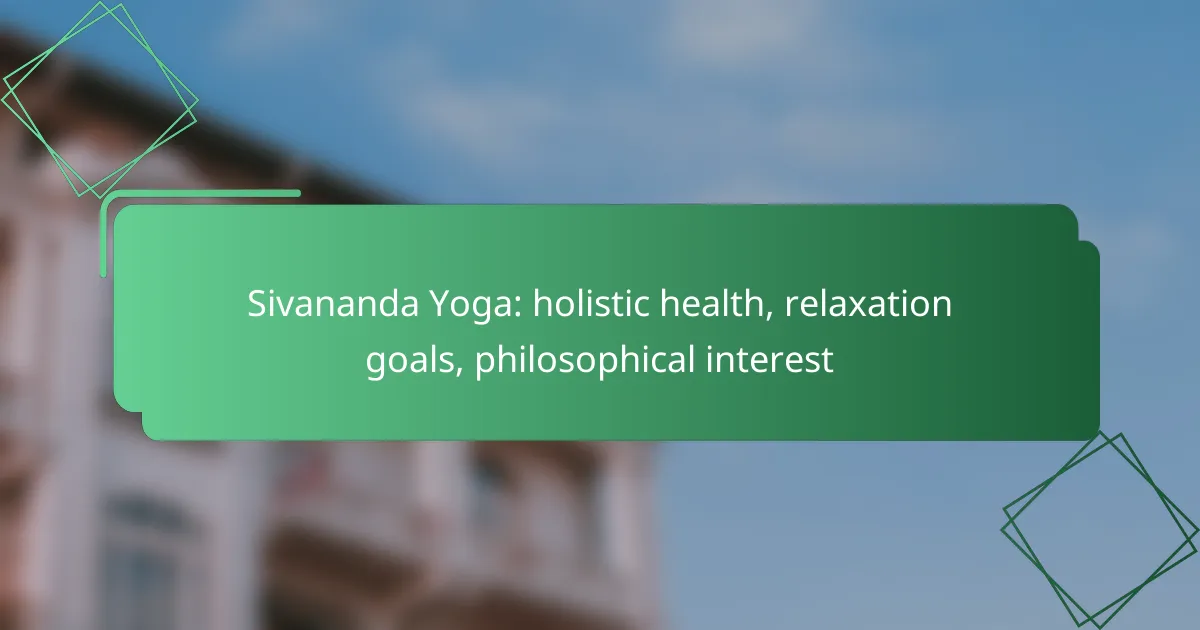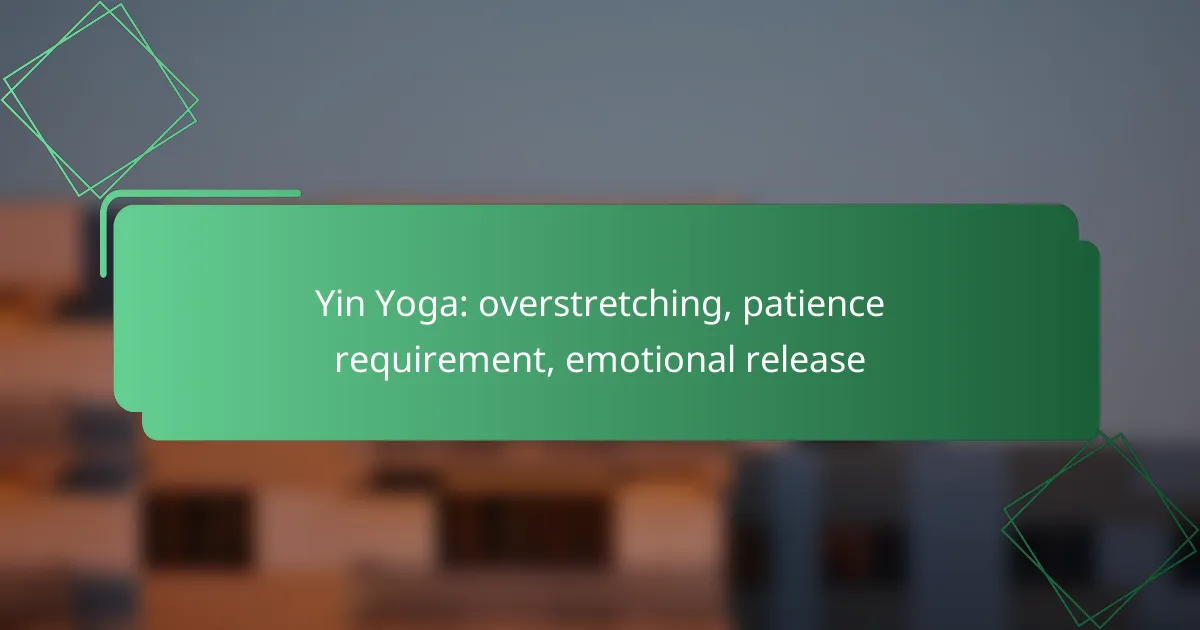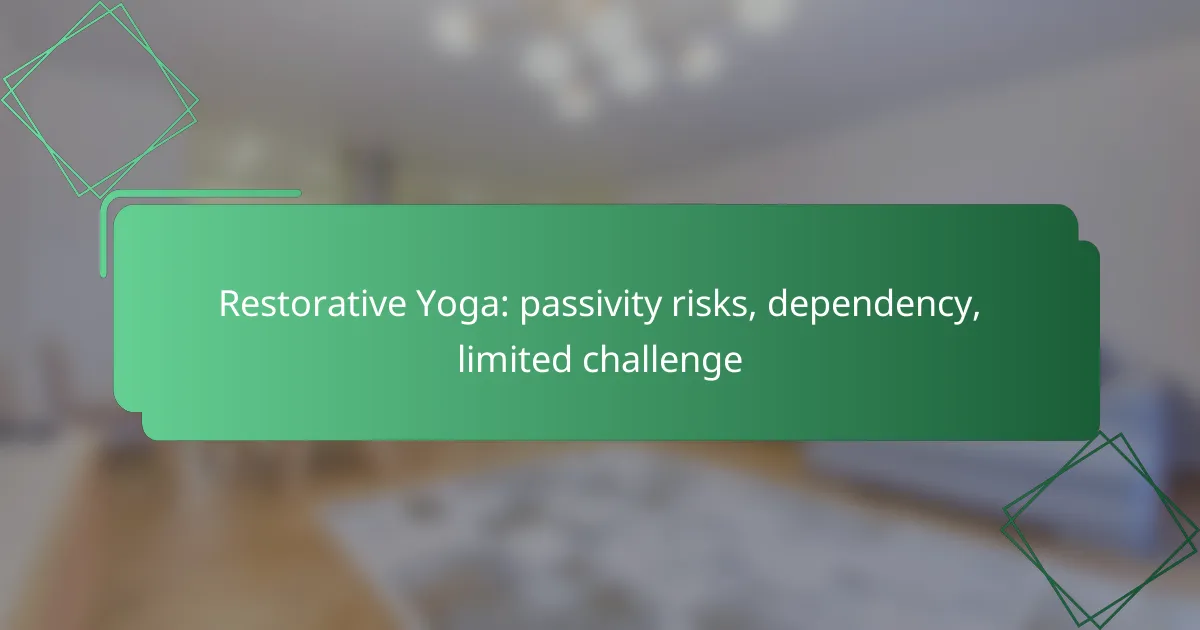Sivananda Yoga is a holistic practice that combines physical postures, breathing techniques, and meditation to foster overall well-being. By focusing on the balance of body, mind, and spirit, it enhances relaxation and promotes mental clarity, making it an ideal choice for those seeking to alleviate stress and improve health in today’s fast-paced world.

How does Sivananda Yoga promote holistic health?
Sivananda Yoga promotes holistic health by integrating physical postures, breathing techniques, and meditation to enhance overall well-being. This practice focuses on balancing the body, mind, and spirit, leading to improved health outcomes and a deeper sense of relaxation.
Physical benefits of Sivananda Yoga
The physical benefits of Sivananda Yoga include increased flexibility, strength, and endurance. Regular practice can help improve posture, enhance circulation, and boost the immune system. Many practitioners report reduced muscle tension and relief from chronic pain conditions.
Incorporating asanas (yoga poses) into your routine can also aid in weight management and improve cardiovascular health. For optimal results, aim for at least two to three sessions per week, focusing on a variety of poses to target different muscle groups.
Mental health improvements
Sivananda Yoga significantly contributes to mental health by reducing stress and anxiety levels. The combination of breath control and meditation fosters a calm mind, helping practitioners manage daily pressures more effectively. Many find that regular practice enhances focus and concentration.
Engaging in this yoga style can also promote emotional resilience, allowing individuals to navigate challenges with greater ease. Consider setting aside time for daily practice, even if just for a few minutes, to experience these mental health benefits.
Spiritual growth through practice
Spiritual growth is a key aspect of Sivananda Yoga, as it encourages self-awareness and a deeper connection to one’s inner self. The philosophy behind this practice emphasizes compassion, mindfulness, and living in harmony with others. This holistic approach fosters a sense of purpose and fulfillment.
To enhance spiritual development, practitioners are encouraged to incorporate meditation and self-reflection into their routine. Joining a community or attending retreats can also provide support and inspiration on this journey toward spiritual enlightenment.
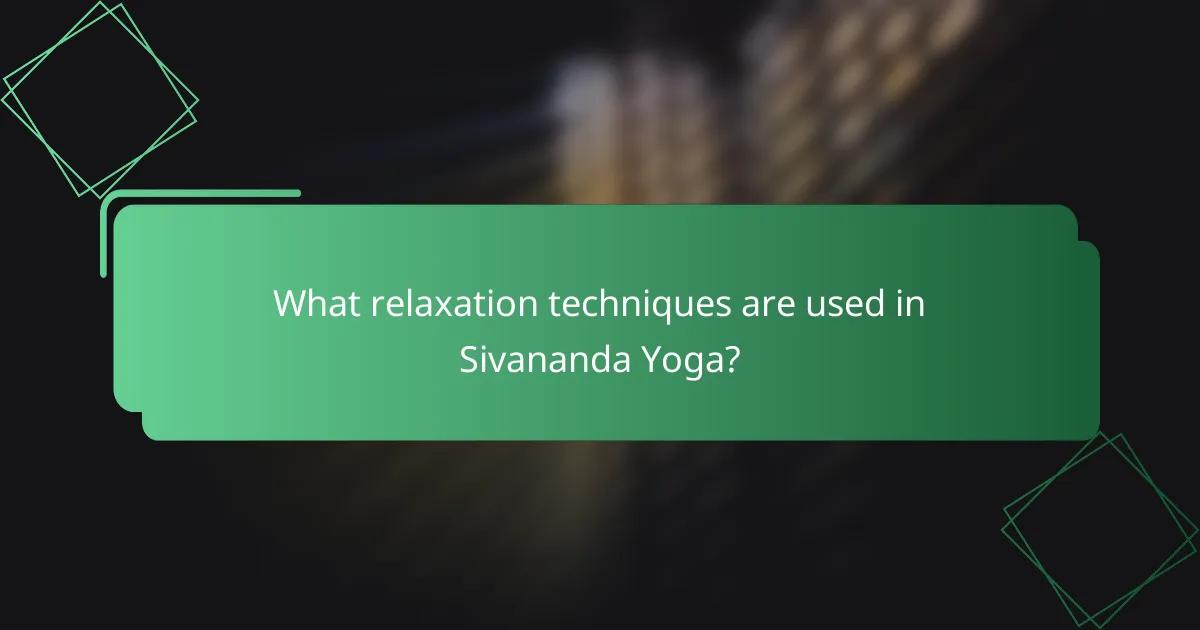
What relaxation techniques are used in Sivananda Yoga?
Sivananda Yoga incorporates various relaxation techniques that promote mental and physical well-being. Key methods include breathing exercises, meditation practices, and specific asanas designed to alleviate stress and enhance relaxation.
Breathing exercises (Pranayama)
Breathing exercises, known as Pranayama, are fundamental in Sivananda Yoga. These techniques focus on controlling the breath to increase energy and calm the mind. Common practices include deep abdominal breathing and alternate nostril breathing, which can help reduce anxiety and improve concentration.
To practice Pranayama effectively, find a quiet space, sit comfortably, and begin with a few minutes of deep breathing. Aim for a slow, steady rhythm, gradually increasing the duration of each breath as you become more comfortable.
Meditation practices
Meditation is a core component of Sivananda Yoga that fosters relaxation and self-awareness. Techniques often involve focusing on the breath or a specific mantra to quiet the mind. Regular meditation sessions can lead to improved emotional health and a greater sense of peace.
For beginners, starting with just 5 to 10 minutes of meditation daily can be beneficial. Gradually increase the duration as you become more accustomed to the practice, aiming for a calm and distraction-free environment.
Asanas for stress relief
Asanas, or yoga postures, play a crucial role in relieving stress within Sivananda Yoga. Poses such as Child’s Pose, Forward Bend, and Legs-Up-the-Wall are particularly effective for promoting relaxation and releasing tension in the body. These postures encourage deep stretching and help to calm the nervous system.
Incorporating a few gentle asanas into your daily routine can significantly enhance your relaxation efforts. Aim to hold each pose for several breaths, focusing on the sensations in your body and allowing yourself to unwind with each exhale.
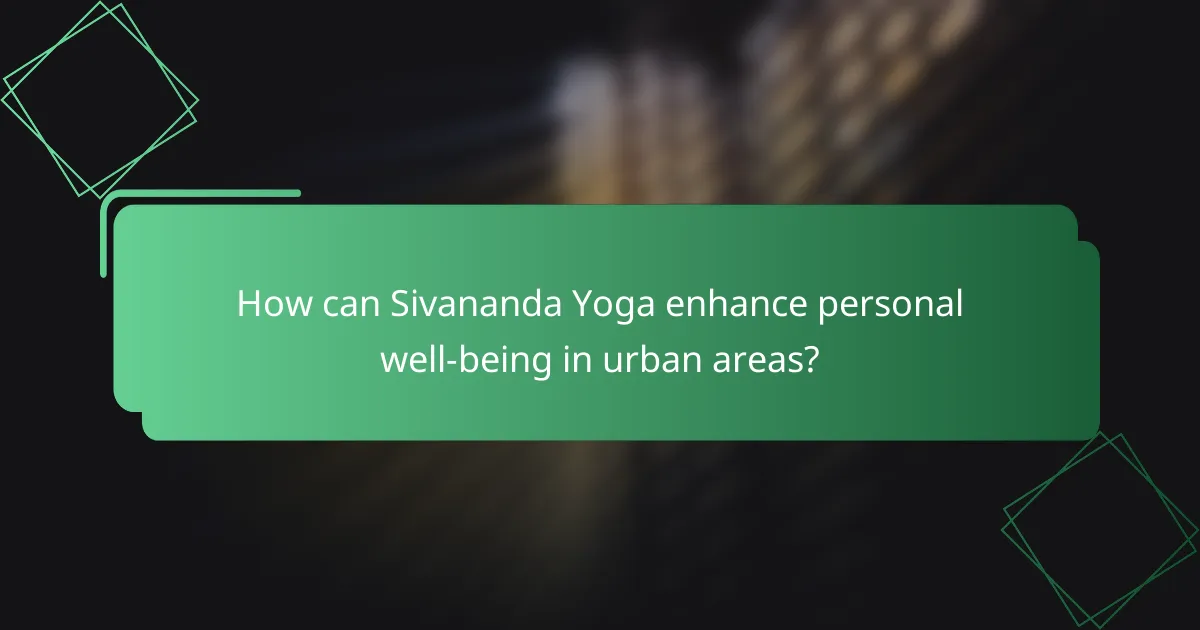
How can Sivananda Yoga enhance personal well-being in urban areas?
Sivananda Yoga can significantly enhance personal well-being in urban areas by promoting relaxation, mental clarity, and physical health. Its holistic approach integrates physical postures, breathing techniques, and meditation, making it particularly beneficial for individuals facing the stresses of city life.
Accessible classes in major cities
Many major cities offer accessible Sivananda Yoga classes, often held in community centers, yoga studios, and wellness facilities. These classes typically cater to various skill levels, making it easy for beginners to join and experience the benefits.
Pricing for classes can vary, generally ranging from $15 to $30 per session, with many studios offering package deals or membership options that reduce costs. Look for introductory offers to try out different classes without a significant financial commitment.
Community support and group sessions
Participating in Sivananda Yoga group sessions fosters a sense of community and support among practitioners. These sessions often encourage interaction and shared experiences, which can enhance motivation and commitment to personal well-being.
Many urban centers host regular community events, such as group meditations or yoga days in parks, which are often free or donation-based. Engaging with others can help sustain your practice and provide emotional support.
Local retreats and workshops
Local retreats and workshops focused on Sivananda Yoga offer immersive experiences that deepen practice and understanding. These events typically take place in serene environments, providing a break from the urban hustle.
Retreats can range from weekend getaways to week-long immersions, with costs varying widely based on location and amenities. Look for options that include meals and accommodations to simplify planning and maximize relaxation.
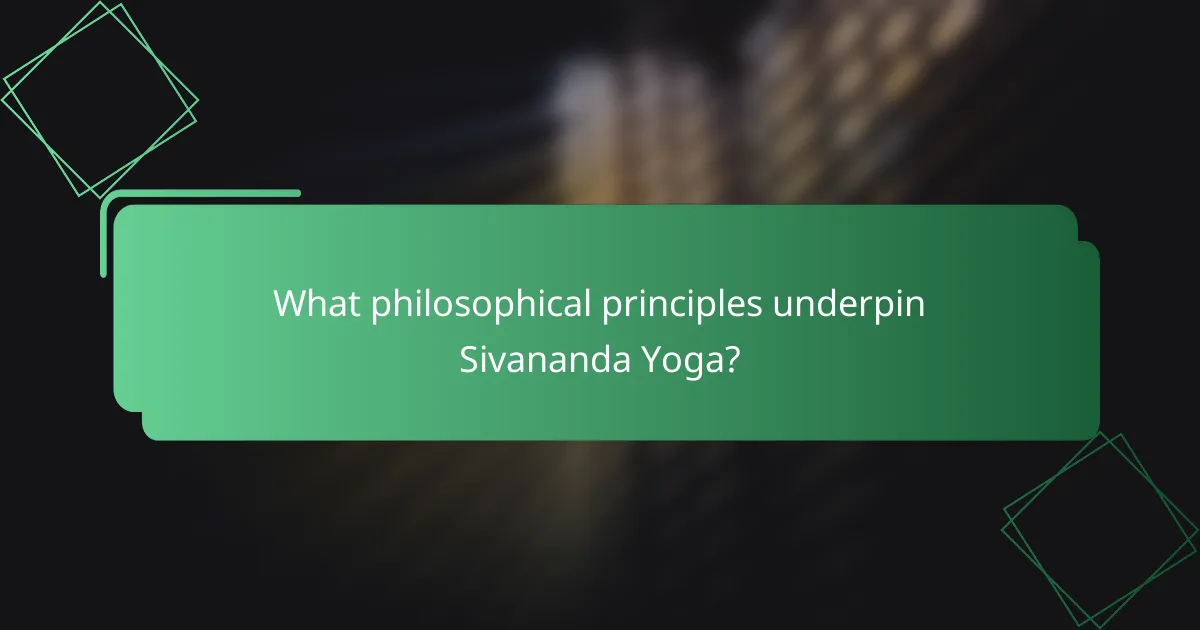
What philosophical principles underpin Sivananda Yoga?
Sivananda Yoga is grounded in a philosophy that emphasizes the unity of body, mind, and spirit. Its core principles focus on self-realization, the importance of a healthy lifestyle, and the practice of compassion and service to others.
Five points of yoga
The five points of yoga in Sivananda Yoga are: proper exercise, proper breathing, proper relaxation, proper diet, and positive thinking. These elements work together to promote holistic health and well-being.
1. **Proper Exercise**: Engaging in asanas (yoga postures) enhances physical strength and flexibility.
2. **Proper Breathing**: Pranayama techniques improve respiratory function and calm the mind.
3. **Proper Relaxation**: Techniques like savasana help reduce stress and rejuvenate the body.
4. **Proper Diet**: A vegetarian diet is encouraged to support physical health and ethical living.
5. **Positive Thinking**: Cultivating a positive mindset fosters emotional resilience and mental clarity.
Integration of yoga philosophy in daily life
Integrating Sivananda Yoga philosophy into daily life involves applying its principles beyond the mat. This can include mindful eating, regular physical activity, and fostering a compassionate attitude towards oneself and others.
Practicing gratitude and positive affirmations can enhance mental well-being. Additionally, setting aside time for relaxation and reflection can help maintain balance amidst daily stresses.
To effectively integrate these principles, consider creating a daily routine that includes yoga practice, meditation, and healthy meal preparation. This holistic approach supports overall wellness and aligns with the core values of Sivananda Yoga.
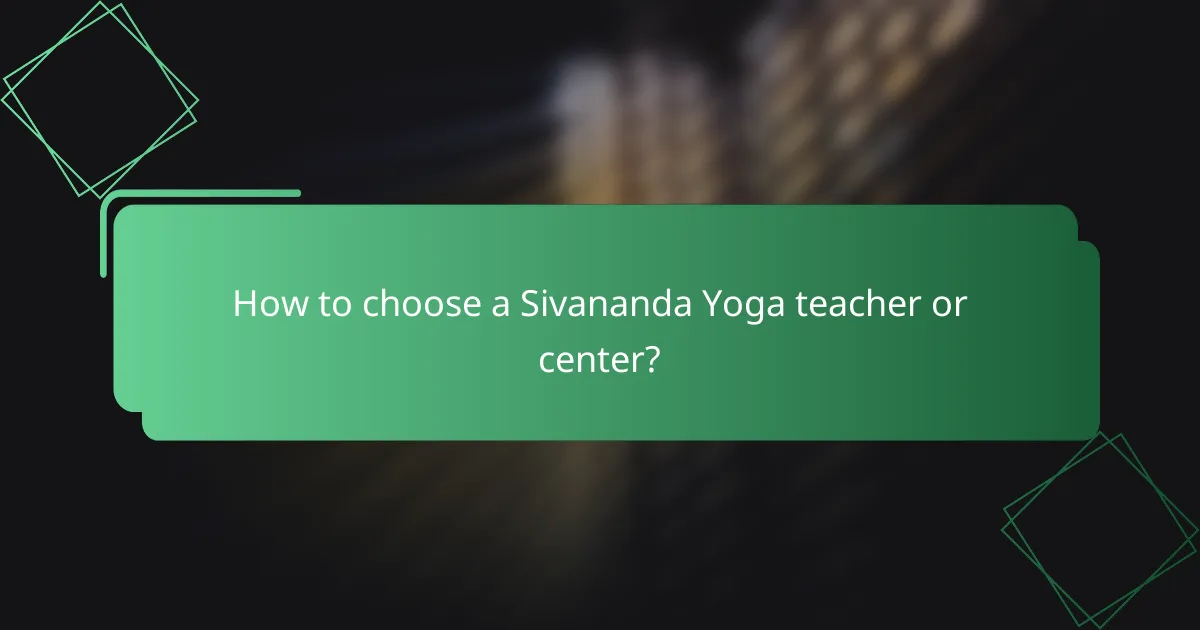
How to choose a Sivananda Yoga teacher or center?
Selecting a Sivananda Yoga teacher or center requires careful consideration of their qualifications, reputation, and alignment with your personal goals. Look for instructors with recognized certifications and positive feedback from students to ensure a supportive learning environment.
Certification and training of instructors
Instructors should ideally hold certifications from recognized Sivananda Yoga organizations, which typically require extensive training in yoga philosophy, asanas, and teaching methods. Look for teachers who have completed a minimum of 200 hours of training, as this is a common standard in the field.
Additionally, inquire about ongoing education and experience. A teacher who regularly attends workshops or retreats demonstrates a commitment to personal growth and staying current with yoga practices.
Reputation and reviews of local centers
Researching the reputation of local Sivananda Yoga centers is crucial. Check online reviews on platforms like Google or Yelp, and consider asking for recommendations from friends or local yoga communities. Positive feedback often indicates a welcoming atmosphere and effective teaching.
Visit the center if possible to observe classes and meet instructors. This firsthand experience can help you gauge whether the center’s approach aligns with your relaxation and holistic health goals.

What are the costs associated with Sivananda Yoga classes?
The costs of Sivananda Yoga classes can vary widely based on location, class type, and duration. Generally, students can expect to pay anywhere from moderate to higher fees depending on the urban setting and the specific offerings of the yoga center.
Average class fees in urban areas
In urban areas, Sivananda Yoga class fees typically range from $15 to $30 per session. Some studios may offer discounts for purchasing class packages or memberships, which can lower the per-class cost significantly.
For example, a package of ten classes might be priced around $120 to $250, providing a more economical option for regular practitioners. Additionally, many studios offer introductory specials for new students, allowing them to try a few classes at a reduced rate.
It’s advisable to check local studios for their specific pricing structures and any ongoing promotions. Understanding the fee structure can help you budget effectively for your yoga practice.

